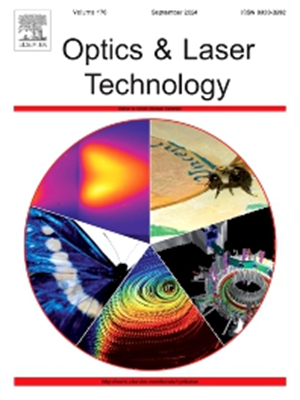Formation mechanism of surface quality in 4H-SiC wafers sliced via picosecond laser with gradient Energy-Modulation Multi-Pass modification process
IF 5
2区 物理与天体物理
Q1 OPTICS
引用次数: 0
Abstract
Ultrafast laser slicing is a promising method for slicing silicon carbide (SiC) wafers. However, the surface quality of the sliced wafer significantly impacts subsequent processing efficiency and material utilization. This paper investigates the effects of laser processing parameters on the surface quality of sliced 4H-SiC wafers and proposes a gradient energy-modulation multi-pass strategy. The results indicate that excessive pulse energy or scanning passes degrade the cracked layer morphology and increase surface roughness. Compared to constant-energy multi-pass scanning, gradient energy modulation with ΔEp = 1.7μJ improves surface quality. The area of the modified region and the boundary defect region decreased by 28 % and 20 %, respectively. By using the gradient energy-modulation scanning strategy, a 5 × 5 mm sample with an average Sa = 224 nm was obtained, and the surface roughness was reduced by 80 %. Boundary defects are refined from micron-scale cracks to nanometer-scale voids. This study offers valuable insights and practical methodologies for high-quality SiC wafer slicing, minimizing material loss and enhancing downstream efficiency.
皮秒激光梯度能量调制多道改性4H-SiC片表面质量形成机理
超快激光切片是一种很有前途的碳化硅片切片方法。然而,薄片的表面质量对后续加工效率和材料利用率有很大影响。研究了激光加工参数对4H-SiC片表面质量的影响,提出了一种梯度能量调制多通策略。结果表明,过大的脉冲能量或扫描次数会降低裂纹层的形貌,增加表面粗糙度。与恒能量多道扫描相比,ΔEp = 1.7μJ的梯度能量调制提高了表面质量。改进区域和边界缺陷区域的面积分别减少了28%和20%。采用梯度能量调制扫描策略,获得了平均Sa = 224 nm的5 × 5 mm样品,表面粗糙度降低了80%。边界缺陷从微米级的裂纹细化到纳米级的空洞。本研究为高质量的SiC晶圆切片提供了宝贵的见解和实用的方法,最大限度地减少材料损耗,提高下游效率。
本文章由计算机程序翻译,如有差异,请以英文原文为准。
求助全文
约1分钟内获得全文
求助全文
来源期刊
CiteScore
8.50
自引率
10.00%
发文量
1060
审稿时长
3.4 months
期刊介绍:
Optics & Laser Technology aims to provide a vehicle for the publication of a broad range of high quality research and review papers in those fields of scientific and engineering research appertaining to the development and application of the technology of optics and lasers. Papers describing original work in these areas are submitted to rigorous refereeing prior to acceptance for publication.
The scope of Optics & Laser Technology encompasses, but is not restricted to, the following areas:
•development in all types of lasers
•developments in optoelectronic devices and photonics
•developments in new photonics and optical concepts
•developments in conventional optics, optical instruments and components
•techniques of optical metrology, including interferometry and optical fibre sensors
•LIDAR and other non-contact optical measurement techniques, including optical methods in heat and fluid flow
•applications of lasers to materials processing, optical NDT display (including holography) and optical communication
•research and development in the field of laser safety including studies of hazards resulting from the applications of lasers (laser safety, hazards of laser fume)
•developments in optical computing and optical information processing
•developments in new optical materials
•developments in new optical characterization methods and techniques
•developments in quantum optics
•developments in light assisted micro and nanofabrication methods and techniques
•developments in nanophotonics and biophotonics
•developments in imaging processing and systems

 求助内容:
求助内容: 应助结果提醒方式:
应助结果提醒方式:


